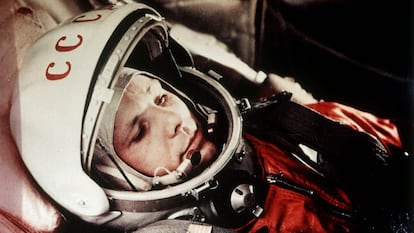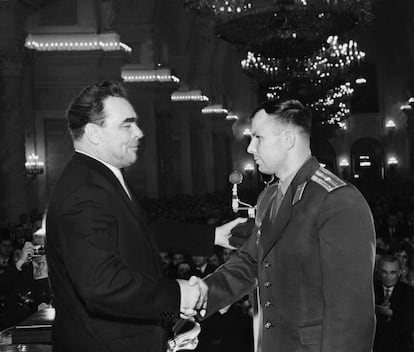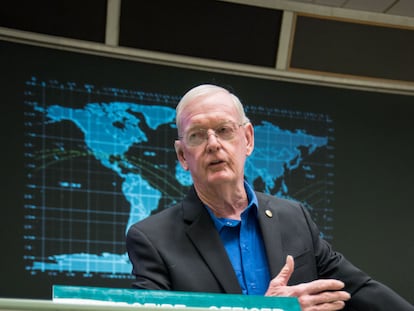Yuri Gagarin’s troubled re-entry into Earth
A new book brings a fresh focus on the first astronaut to travel in space and links the stories of the race between the Soviet Union and the USA to reach the Moon first

It has been 60 years since a man first left the Earth to travel in space. That man was Yuri Aleksevevich Gagarin, a name inscribed forever in the annals of human discovery. Gagarin was the perfect candidate, the prototype of the Soviet “new man” in the context of Cold War tension between the world’s two superpowers. A new book by Stephen Walker, Beyond, considers Gagarin’s legacy and that of the NASA astronauts who would become known as the Mercury Seven. It is a work whose master stroke, according to a Times review, is to bring together in one book the two stories of the Soviet and US space programs.
In 1959, Gagarin signed up for a classified program designed to recruit future cosmonauts. Sputnik 1 had been launched just two years earlier and the only living being to have flown in space at that stage was Laika, a stray dog plucked off the streets of Moscow. The selection process was brutal. An initial 350 candidates were whittled down to 100, then 20 and finally six. According to legend Sergei Korolev, the Soviet Union’s pre-eminent rocket engineer and spacecraft designer, had a preference for Gagarin not only due to his excellent performance during tests but also because he was the only candidate to admit to being turned inside out by a session in the High-G centrifuge. All of the others claimed to have enjoyed the experience. Korolev surmised that only Gagarin could be trusted to provide an honest report without sugar-coating when the time came for the real thing.

On April 12, 1961, Gagarin launched aboard the Vostok 1, completing a 90-minute orbit of the Earth that turned him into a global celebrity. Of his five remaining comrades in the program, four traveled in space in similar capsules. The fifth, Grigori Nelyubov, was dismissed following a drunken episode of indiscipline. In his place, the final mission of the program was assigned to Valentina Tereshkova, who later married (and divorced) the third cosmonaut in space, Andrian Nikolayev.
In a modern rendition of damnatio memoriae, Nelyubov was expunged from the records of the Soviet space program. He was airbrushed from all official photographs, sometimes with a less than meticulous eye that left a hand or a foot visible. From there originated the legend of the Soviet cosmonauts lost in space with their identities never officially recognized. Nelyubov in reality was assigned to a remote airbase in Siberia, where he died in 1966 under the wheels of a train near Vladivostok.
Gagarin’s flight took place at precisely the moment NASA was preparing to send its first astronaut into space, marking the beginning of the man-in-space program that would later become known as the Mercury Project. Once again, the Soviet Union had gained the upper hand. Given the urgent need to restore national pride, John F. Kennedy decided to land a man on the Moon “before the end of the decade.” And, of course, before the Soviets did.

NASA had selected seven military aviators to form its astronaut corps, none of them women. A parallel program financed by private investors included 13 female astronaut candidates but it would be another 20 years before NASA sent a woman, Sally Ride, into space. The first male astronaut was Alan Shepard, who piloted the tiny Freedom 7 after being blasted into suborbital flight by a rocket derived from the German V-2 developed by Wernher von Braun. Even though Shepard did not achieve orbit, reaching an altitude of 101.2 nautical miles, NASA was able to sell it as an achievement to match Gagarin’s feat. A series of features in Life magazine had converted Shepard and his NASA colleagues into the epitome of the all-American hero before they had even left the Earth.
Of the Mercury Seven – Scott Carpenter, Gordon Cooper, John Glenn, Gus Grissom, Wally Schirra, Alan Shepard and Donald Slayton – six would eventually travel in space. A minor heart issue saw Donald Slayton removed from active service and he was named Director of Flight Crew Operations, a position from which he wielded considerable influence. He was responsible for deciding who would fly each mission and among his stable of astronauts were Neil Armstrong and Buzz Aldrin, originally assigned to back-up crews under Slayton’s rotation policy.
When the Apollo Moon landing missions began, Slayton intended that at least one of the original Mercury astronauts would be among the crews. But there was not much to choose from. Grissom had died in the Apollo 1 fire in 1967. Glenn, who had always carried the aura of the quintessential hero, was a senator in Washington. Carpenter had joined the SEALAB project as an aquanaut. Schirra had left NASA to work with CBS anchorman Walter Cronkite on the legendary broadcasts covering each of the space program’s missions. And Cooper had found his way onto the black list for his perceived laissez-faire attitude during testing.
That left only Alan Shepard, who had been restored to active service after recovering from Ménière’s disease, which grounded him for several years. He used the time wisely, becoming the first millionaire astronaut through real estate investment. He was given command of Apollo 14 and landed on the Moon in 1972. It was the third successful lunar landing and Shepard became the fifth and the oldest man to walk on the Moon, as well as the only one of the Mercury Seven to do so.
After exploring the Fra Mauro formation on the lunar surface in line with the mission objective, Shepard ensured his own place in the history books of space exploration when he produced two golf balls and the head of nine-iron he had smuggled aboard Apollo 14. In front of cameras transmitting to the world, he attempted a couple of swings. He missed the first but sent the next “miles and miles” over the lunar surface, a slight exaggeration but nonetheless the defining image and crowning moment of the Apollo 14 mission.
As for Gagarin, his elevation to the position of Soviet hero was to prove counterproductive. He was sidelined from active missions to make sure he was not exposed to any form of accident like the one that cost the life of his comrade and friend Vladimir Komarov. But the Kremlin’s attempt to wrap their hero in cotton wool proved ineffectual. Gagarin was killed when a MiG-15 fighter he was piloting under the guidance of an instructor crashed during a routine flight in 1968. He had just turned 34.
English version by Rob Train.
Tu suscripción se está usando en otro dispositivo
¿Quieres añadir otro usuario a tu suscripción?
Si continúas leyendo en este dispositivo, no se podrá leer en el otro.
FlechaTu suscripción se está usando en otro dispositivo y solo puedes acceder a EL PAÍS desde un dispositivo a la vez.
Si quieres compartir tu cuenta, cambia tu suscripción a la modalidad Premium, así podrás añadir otro usuario. Cada uno accederá con su propia cuenta de email, lo que os permitirá personalizar vuestra experiencia en EL PAÍS.
¿Tienes una suscripción de empresa? Accede aquí para contratar más cuentas.
En el caso de no saber quién está usando tu cuenta, te recomendamos cambiar tu contraseña aquí.
Si decides continuar compartiendo tu cuenta, este mensaje se mostrará en tu dispositivo y en el de la otra persona que está usando tu cuenta de forma indefinida, afectando a tu experiencia de lectura. Puedes consultar aquí los términos y condiciones de la suscripción digital.











































